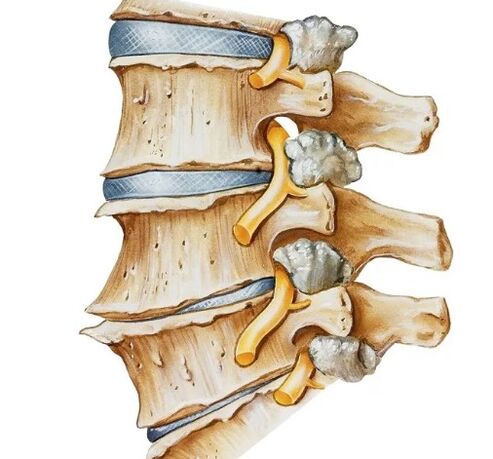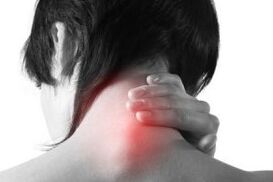Onosteochondrosis of symptoms and treatment of cervical spineThey will vary depending on the type of deformation in the cervical vertebra that is obtained in relation to their long -term inflammation, inflammation or mental effects.

The disease is often chronic, indicated by many clinical symptoms caused by squeezing the nerve roots and blood vessels coming out of the vertebra. Their compression is caused by wearing or deforming the intervertebral disc (reducing their height, loss of elasticity, deformation of fibrous rings or breaking). Cervical osteochondrosis is a common disease that occurs at any age after 20 years.
The cause of the pathology is in the change in the spine. First of all, changes in the intervertebral disc occurs: their elasticity, strength and height decreases, their fibrous rings are defective, protrusions (early stages of intervertebral hernia), and hernia appear. All of these changes cause bone growth in the vertebra (osteophytes), leading to displacement, and then - to lose cervical vertebral mobility. Because the spine is a "case" of flexible protector for the spinal cord, the change in damage to the intervertebral disc and the loss of the flexibility of the vertebral vertebrae is detrimental to the nerve and vascular structure of the spinal cord. They are subject to squash, displacement, which interfere with cerebral circulation and conservation not only the cervical and shoulder zones, but also the internal organs, the lower leg.
The older the patient, the more intervertebral discs have changed under the influence of age -related muscle, long load on the spine, injury, slowing down physical activity, improper posture formation, stressful situations and increased tension in the neck, shoulder girdle, spinal inflammation, and more.

Due to the anatomical structure, the cervical spine is more vulnerable to pathology, as the vertebral is the most portable and very tight in connection with each other. In addition, the cervical vertebra has poor muscle protection. Often, degenerative changes develop in the most portable intervertebral disc 5. 6, 7 cervical vertebral.
What are the symptoms of cervical osteochondrosis
Diversity and inconsistency of symptoms
Osteochondrosis of symptoms and treatment of cervical spineIt should be considered comprehensive and in conjunction with the type and severity of the intervertebral disc. The signs of cervical osteochondrosis are diverse and contradictory, as it depends on the localization and strength of the manifestation of the intervertebral disc deformation process, the peculiarity of compression or the root of the nerve and blood vessels, as well as the location of the muscles and organs.
Therefore, often patient complaints are not directed at neurologists, but to other experts: cardiologists, therapists, otolaryngologists, optics, rheumatologists, and so on. At the same time, neuropathologists can diagnose cervical osteochondrosis based on brain and spinal cord, brain ultrasound, ECG, and others.
Three sets
Experienced experts know about thirty different options combination of cervical osteochondrosis symptoms. It is impossible to describe all the signs of manifestations of this common disease, so let's stayThree complexThe main symptoms that characterize certain impaired functions of the central nervous system.
The first complex of basic symptoms occurs for the peripheral function of the nervous system. The department is represented by other nerves and elements that leave the brain and spinal cord, and are divided into somatic and autonomic systems.
In short, the first cervical osteochondrosis symptoms are shown in the form of various localization of pain. This does not mean that the signs are only painful, often the pain is combined with the function of the defective body. But especially - this is a persistent or periodic pain in the neck, the appearance of the patient connects to hypothermia, prolonged pressure or in uncomfortable pose, heavy lifting, sharp head turn.
Pain, shooting or similar to shock. Their localization depends on certain muscle tension associated with certain roots of the nerves, which are squeezed by the vertebra. Therefore, pain can spread to the neck, nape, shoulders, one or both hands, radiating to the chest - to the heart, liver. In addition, there are complaints of crisis or cracks in the vertebra in the cervical region when the head moves, as well as the stiffness of the head rotation movement.
In the onset of acute illness, the pain and spasm of the neck muscles forced the patient to be in a state of tendency to turn and turn away. Burning pain may occur between the shoulder blades if the cervical vegetative formation is compressed and their blood supply is disrupted. Such pain usually increases with physical and emotional stress.
Often there are swelling, pale and cooling, their numbness, rapid heartbeat, pain in the liver, narrowing or developing students, and others as they are affected by the shoulders and spatular areas, symptoms of dysfunctional changes in the shoulder joint may occur. Patients complain of pain, inability to raise and take hands to the side, stiffness of the shoulder joint.
The second complex of the symptoms of cervical osteochondrosis occurs due to the impaired function of the spinal cord, and is characterized by engine disorders.
Disruption of spinal cord function is due to compression due to loss of pulpoos nucleus from disc or injury with solid disc and growth (osteophytes). Depending on the mechanism of exposure to the spinal cord, the following motor disorders are observed: muscle rigidity -oxipital and cervical muscles, arm and leg weakness, with increased leg muscle tone and decreased tone and weight loss; loss of temperature and pain sensitivity; Strong fatigue, coordination is affected.
The third set of symptoms characterizes blood supply disruption in the brain vessels and skull nerve pathology caused by deformation in the cervical vertebra. Symptoms of vascular pathology are indicated.
Symptoms of vascular disorder characteristics:
- neurotic conditions (irritation, longing, anxiety, fatigue, sleep disorders);
- faint; headache and dizziness; nausea and vomiting;
- noise and ring in the ear, hearing loss;
- Visual disorders (dark in the eyes, fog, blinking points, visual disorders);
- The glorious mining syndrome (sore throat, foreign object taste, dryness, difficulty swallowing).
Symptoms of cervical osteochondrosis are unclear, and should be considered in the complex and depend on the pathological process of the spine.
Only qualified specialists can address the clinical manifestations of the disease, make the right diagnosis and prescribe proper treatment of the cause of the detection.
How to treat the disease
Osteochondrosis of cervical spinal symptoms and treatment depends on the patient's condition, severity of the disease, the nature of damage to the cervical vertebra.
During the acute period, hospitalization and medication may be required. Usually use analgesics, novocaine muscle blockade, muscle relaxants that relieve muscle cramps; Chondroproprotectors for cartilage nutrition; Sedative drugs that calm the nervous system, vitamin B, increase neuromuscular conductivity. The treatment of cervical spinal osteochondrosis is always long, and it should be complex.
During the remission period, when acute symptoms are not present, physiotherapy (electrophoresis, ultrasound, etc. ) are widely used, therapeutic physical education, massage, and non -traditional procedures, for example, acupuncture, should be prescribed.

Many conservative methods of osteochondrosis treatment are known, which can stop the development of the disease. However, each patient needs an individual course of treatment taking into account the level of the disease, the characteristics of the body, gender and age. The purpose of treatment of cervical osteochondrosis is:
- Elimination of pain and edema at the site of inflammation.
- Relaxation of the neck tense of the neck.
- Release of nerve roots.
- Increased blood circulation.
- Activation of metabolism.
- Increase the power of the intervertebral disc.
Targeted complex treatments can prevent protrus and intervertebral hernia.
In order for the symptoms and treatment of osteochondrosis and the treatment to be not launched, and severe complications of the disease must begin timing in timely treatment.

























